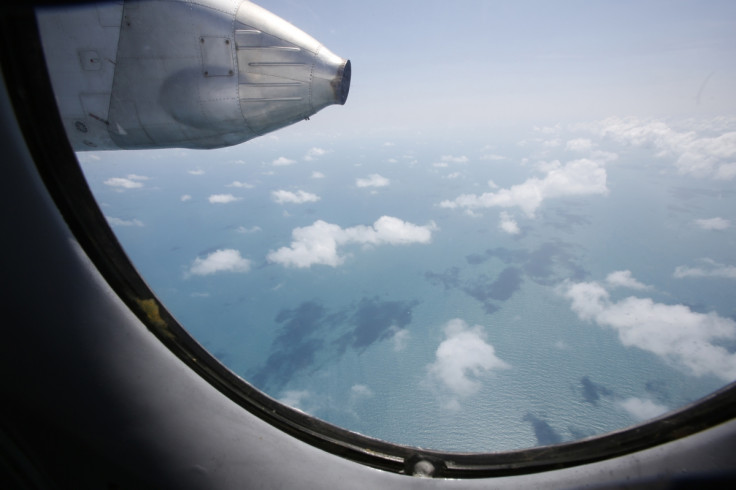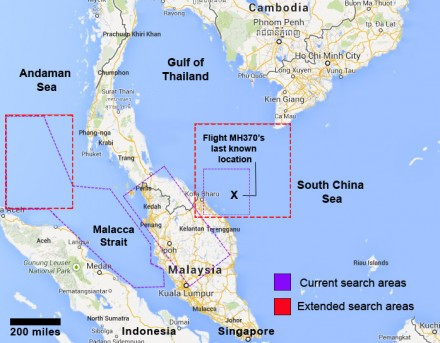Malaysia Airlines MH370: Which Detection Methods Did Aviation Experts Use?

Despite a plethora of advanced aviation technology and global experts joining the search, the missing Malaysian Airlines jet has still not been found - a week after it vanished while flying between Kuala Lumpur and Beijing. Dr Matthew Greave, a senior lecturer in accident investigation at world-renowned Cranfield Safety and Accident Investigation Centre, tells IBTimes UK about the detection methods used by air investigators in the hunt for Malysian Airlines' missing flight MH370.
Radar At the basic level, a radar is used. This offers a bearing and a range of the aircraft.
Transponder A transponder is used at the next level. This communicates the speed and the height of the aircraft, from which the location can be roughly figured out.

Automatic dependent surveillance-broadcast (ADSB) The next level is the ADSB. This is where the aircraft gives its location via satellite. It broadcasts back to radio at ground station. However, you have to be in range of a ground station.
The issue in the Malacca Strait is that, if you head out towards the western islands, you become out of range of a ground station.
Aircraft Communications Addressing and Reporting System (Acars) system This allows aircraft to communicate with short text message. Flight MH370 sent two "text messages" which both said that the engine was fine.
Rumours have been emerging that the airliner continued to fly for four or five hours after it was last detected but the Malaysian Transport Minister denied the claims.
Emergency Location Emitter (ELT) This is the distress signal. When it's subjected to high-altitude drops, or if the plane breaks up, the ELT transmits to emergency satellites to say "I'm this unit and this is where I am". Specific units are connected to the airline and then it is possible to identify which plane it is.
One problem with ELTs is that airliners are very high-energy. These systems have to wait until you have the accident, they cannot forewarn that an accident is occurring.
Often they are destroyed or submerged before they get a chance to communicate with the satellite.
Satellite Communication Aircraft will use satellite communication for a few things but not reporting where it is. Not every aircraft has satellite communications. Not all aircraft are state of the art and therefore it is challenging to implement an industry-wide communication system.
Black Box The black box is fitted with an underwater locator beacon (ULB). This provides a solar ping once a second which can only be heard in the water. You need to be relatively close to it to pick up a signal. Several miles on a good day, not hundreds of miles.
What other detection methods could have been used?
It varies by plane. Not everywhere has radar coverage nor satellite coverage, for example the [North and South] Poles. So there is nothing else that this aircraft could have done or the authorities could have done to find the aircraft.
Satellite imagery has been used to find the wreckage but the Chinese mistakenly believed they had found the wreckage.
Short of anything that the security services or the military have in their possession, there is nothing the airline could have done.
Are we at a stage where we can only find out what happened to MH370 if we find the black box or the debris?
They will struggle to say anything about this accident without the black box or the discovery of the debris. They can look at tech logs or crew records but these will not be conclusive. Without any wreckage at all, it will be very hard.
Do you think this is a case of the "Swiss Cheese Factor"? (An unusual scenario where all the holes in the Swiss cheese line up, proving the improbable can occur)
There are failures in the system all the time. However, the aviation industry has procedures to prevent these failures from bringing an aircraft down. When one mistake is made, it is not catastrophic.
There is more than one pilot, more than one engine. So, when there is an accident, it is an unlikely series of events.
For example, if there was a mechanical failure, it means that there would have been problems upstream. There would not be one cause.
So, what do you believe happened to flight MH370?
I do not know what happened. It may have broken up at height but, if so, it would have left a bigger wreckage trail. This would have been easier to find, given the mass search effort.
It comes down to: it's either in one piece, or not at all.
We need to find the wreckage first.
FLIGHT MH370 FACTBOX
Flight MH370 took off from Kuala Lumpur International Airport en route to Beijing at 00:41 on Saturday 8 March (16:41 GMT Friday).
About 50 minutes later, the aircraft lost contact with air traffic control.
No distress call was made.
On board, there were 12 Malaysian crew members and 227 passengers from 14 countries. That included 153 Chinese and 38 Malaysians.
Two Iranian male passengers, Pouria Nour Mohammad Mahread and Delavar Syed Mohammad Reza, were travelling on fake passports. Neither had any apparent links to terrorist groups.
No debris from the plane has been found in the international search.
At least 10 countries, including China, the US and Singapore, were using a total of 42 ships and 39 aircraft to search for the missing plane in the South China Sea, the Malacca Strait and the Andaman Sea.
© Copyright IBTimes 2025. All rights reserved.






















